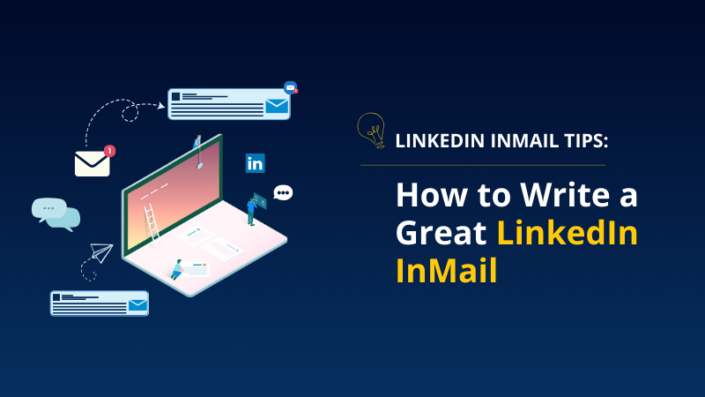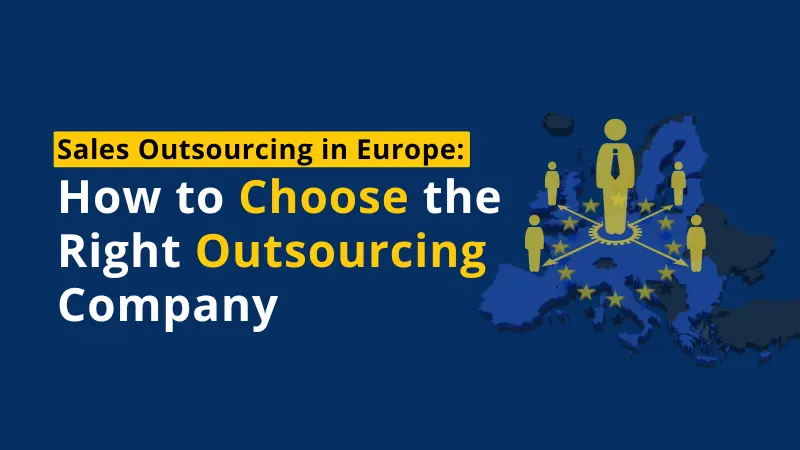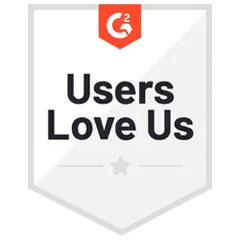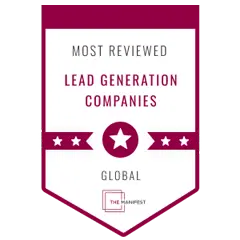When it comes to professional networking, LinkedIn has become the go-to platform for connecting with potential clients, partners, and peers in your industry, and job opportunities. But, you see, sending regular connection requests is easy-peasy. What’s tricky is creating an effective LinkedIn InMail that really grabs someone’s attention.
You may be wondering, why you should reach out to people using InMail when there’s regular mail that exists. Well, let me tell you this, LinkedIn InMail is a fantastic tool that gets a response from 10-25% of prospects – that’s three times more than regular emails with the same message.
Today, we’ll show you how to write great LinkedIn InMail for lead generation. But before that, let’s start with the basics—understanding what LinkedIn InMail is.
What is LinkedIn InMail?
LinkedIn InMail is a premium feature that allows you to send direct messages to people outside your network. Unlike regular connection requests, InMail messages offer a direct line of communication to individuals who could be crucial for your business or career advancement. Leveraging the full potential of LinkedIn InMail can significantly boost your lead generation efforts.
Ready to boost your lead generation efforts?
So, What Makes InMail so Powerful?
This has something to do with how InMail works. It’s optimized to work well on mobile within the LinkedIn app, sends quick notifications to your prospects, and has its special inbox in LinkedIn, making sure your message doesn’t get lost. In other words, InMail reaches your prospects in three different ways, making them more likely to pay attention.
Although getting introduced by a mutual contact is the best way to connect, sometimes that’s not an option. When you don’t have a common connection with a prospect, a well-crafted and personalized InMail is your best bet to start a conversation.
Stay with me throughout this blog if you want to improve your LinkedIn InMal open and response rate.
How to Write Effective LinkedIn InMail Messages?
Imagine if you met someone, and instead of saying hello, you immediately asked for a favor or their time, without even introducing yourself or being polite. It’s not something most of us would do in person.
But strangely enough, this happens quite often on LinkedIn—the professional networking platform.
As I’ve mentioned earlier, LinkedIn helps you connect with almost anyone worldwide. However, a lot of people mess up this chance by sending short, robotic messages that don’t really explain why they want to connect, like “Can you help me?” or “I’d like to connect with you on LinkedIn.” That’s not a good approach. It’s lazy, unprofessional, and unlikely to get a response.
Instead, take a little more time to write a personal message. It’s a small effort that can make a big difference.
Steps to writing a LinkedIn InMail message that will get opened.
Here are four steps to help you write a LinkedIn message that will actually get noticed and answered.
Step 1: Start with a clear and concise title
Before writing your message, it’s essential to consider a few questions:
- Do you have a genuine reason to connect with this person?
- Do you already know them and need their advice?
- Are you connected through a mutual contact and want to learn more about them?
- Or is this a complete stranger you’re hoping to establish a new connection with?
Once you’ve clarified your purpose, use that information to create a subject line that’s as specific as possible.
When it comes to reaching out to prospects, your InMail messages need to stand out. Generic and vague subject lines won’t cut it. Instead, consider these strategies to make your messages more engaging and effective.
Instead of using a broad subject like “Following Up,” get to the point. For instance, if you meet a prospect at an event, try something like “Following Up from Our Meeting at [event name].” This not only reminds them of the interaction but also shows that you value the connection.
Rather than a generic “Loved Your Speech,” opt for a more relevant and specific message like “Impressed by Your Thoughts on AI in Healthcare.” This demonstrates that you’ve done your homework and are genuinely interested in their area of expertise
If you share a mutual interest or connection, make it clear in your subject line. For instance, “Connect Request from a Fellow Marketing Enthusiast” establishes common ground and a potential conversation starter.
It’s also best to avoid subject lines like “Mutual Contact?” as they lack clarity.
Find out the Guide on How to Write an Effective LinkedIn InMail
Step 2: Introduce yourself
When you’re prospecting on LinkedIn and come across someone you don’t know well but want to engage with, think of it like meeting a potential business connection in person. You’d typically start with a quick introduction, like “I’m Rebecca– we met at the recent tech expo event” or “I’m Sara, and I admire your work in the field.”
It’s crucial not to skip this step in your prospecting efforts on LinkedIn. Never assume that the person you’re reaching out to will take the time to explore your profile to learn more about you or your shared connections. Instead, be proactive (and respectful of their time) by crafting a concise introduction.
For instance, in the initial paragraph of my InMail message, I introduced myself as follows: “I’m Rebecca Matias, VP of Global Operations at Callbox Inc. I was really impressed by your recent achievements in the industry.”
Another example:
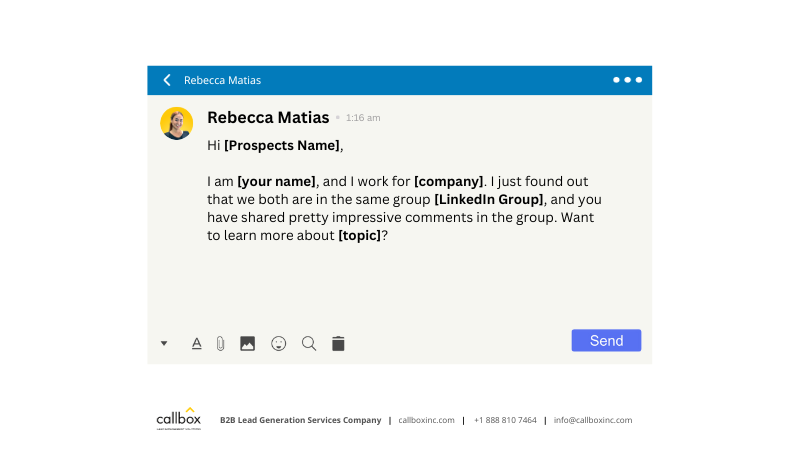
Whether you use this sentence to mention a mutual contact, a past meeting, or a shared professional interest, customizing your introduction for the specific prospect showcases your genuine intent to connect and explore potential opportunities.
Related: 7 LinkedIn Lead Generation and Sales Prospecting Rules To Follow
Step 3: Get straight to the point
When it comes to emails, shorter is usually better. People are busy, and you can lose their interest as fast as you catch it if you go from a brief introduction into a long explanation of why you want to connect or a lengthy list of your qualifications.
So, when you’re writing the second part of your message, which is the main point, get straight to the point. And saying you want to connect just to connect isn’t enough.
- Why do you want to connect?
- Is it because you admire their work or products?
- Are you interested in having them speak at an event or contribute to your website?
- Do you have questions about their company or background?
Let that sentence guide you in writing just one paragraph where you explain a bit more. For instance, “I’m reaching out because I’m interested in exploring a potential partnership. I’ve been impressed with your work in [mention a relevant area] and believe there could be some exciting opportunities for us to collaborate.”
But here’s an important thing to remember: Make sure your request matches your relationship with the person. There’s a big difference between asking someone you don’t know well if they can spare 10 minutes for a phone call to discuss a potential business partnership and requesting them to make a substantial introduction to key stakeholders.
Step 4: Wrap it up with appreciation
The final lines of your message mark the closing moment, similar to saying “I look forward to hearing from you” in a sales pitch. It’s important to be courteous while also ensuring your intention is clear.
Consider something like this:
“In summary, could you spare a moment to [discuss potential collaboration, explore opportunities, provide insights, etc.]? I genuinely value your time and insights.”
Keep in mind that you’re reaching out to a potential business connection, so showing appreciation is essential.
Let us help you grow your business
Now that you’ve been amped with the steps, let’s continue with the best practices checklist for writing an effective LinkedIn InMail Message.
Best practices checklist for writing an effective LinkedIn InMail
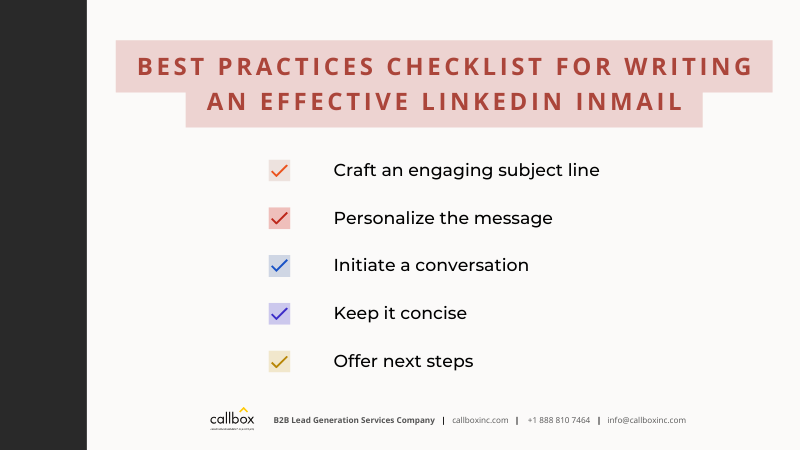
In Summary
When it comes to writing messages on platforms like LinkedIn, there are a few important things to keep in mind. First, your message should start with an interesting subject line that grabs the reader’s attention. You can do this by mentioning things you have in common or by addressing a problem they might be facing. This makes the reader curious and more likely to read your message.
Next, it’s crucial to make your message all about the person you’re writing to. Talk about how what you’re saying benefits them, show that you’ve looked at their profile, and mention any awards or achievements they’ve earned. Using words like “we” instead of “I” can also make your message feel more inclusive and friendly.
Starting a conversation is another key point. Ask questions or share things you both have in common. This not only encourages the person to respond but also shows that you know what you’re talking about.
Keep your message short and sweet. People online tend to have short attention spans, so try to keep your messages to about 100 words or less.
Finally, always end your message with a clear next step, like asking for a meeting or letting them know when you’re available for a chat. This is the best way to make sure you get a response and start building a relationship. Follow these tips, and you’ll be well on your way to writing effective InMail messages in no time.

